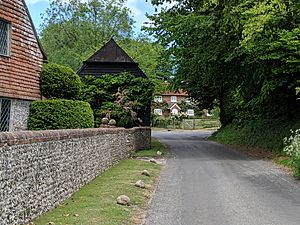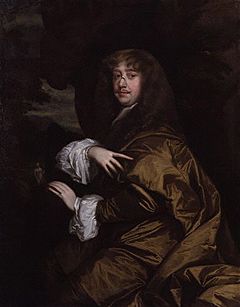Humphrey Bennet facts for kids
Quick facts for kids
Sir
Humphrey Bennet
|
|
|---|---|

Shalden village; Bennet purchased the associated manor in 1632, then sold it in 1653
|
|
| Member of Parliament for Petersfield |
|
| In office August 1660 – December 1667 |
|
| Royalist High Sheriff of Hampshire | |
| In office 1643–1645 |
|
| Personal details | |
| Born | 1605 (baptised) Mortlake, London |
| Died | 30 December 1667 (aged 62) Rotherfield Park, Hampshire |
| Nationality | English |
| Spouses | (1) Mary Smith (1631-1637) (2) Elizabeth Thomas (?-1660) (2) Elizabeth Norton (1661-his death) |
| Children | (1) Thomas (1631/1637-1673); Joanne (1631/1637-1700) (2) Elizabeth (before 1660-1713); Dorothy |
| Alma mater | St John's College, Oxford |
| Occupation | Landowner and soldier |
| Military service | |
| Years of service | 1642 to 1646 |
| Rank | Colonel |
| Battles/wars | First English Civil War Lansdown; Roundway Down; Bristol; Cheriton; Cropredy Bridge; Lostwithiel; Second Newbury; Basing House; Siege of Winchester Castle |
Sir Humphrey Bennet (1605–1667) was a landowner from Hampshire, England. He fought for the Royalists (supporters of the King) during the First English Civil War. He became a high-ranking cavalry officer.
After the war, he went into exile in 1645 but returned home in 1646. He was involved in several secret plans to restore the King during the time England was a republic, known as The Protectorate. When King Charles II returned to power in 1660, Bennet was elected as a MP for Petersfield. In 1664, he also received a position in the Royal Household.
Contents
Sir Humphrey Bennet: A Royalist Soldier
Early Life and Family
Humphrey Bennet was born around 1605 in Mortlake, a part of London. He was the third son of Dorothy May and Thomas Bennet. His father was a rich merchant from the City of London and a former Sheriff of London.
Humphrey had two older brothers, Richard and Thomas, and at least five sisters. His eldest sister, Mary, married Richard Lewknor, who was also an MP. Another sister, Margaret, married Henry Rolle, a top judge. Rebecca, another sister, was the first wife of Bulstrode Whitelocke, an important diplomat during the time England was a republic.
Humphrey Bennet married three times. His first wife was Mary Smith in 1631. They had two children: Thomas, who died in a naval battle in 1672, and Joanne. Mary died in 1637. His second wife was Elizabeth Thomas, with whom he had two daughters, Elizabeth and Dorothy. In 1661, he married his third wife, Elizabeth Norton. She owned an estate near Rotherfield, where Humphrey lived until his death.
Fighting for the King: The English Civil War
Humphrey Bennet studied law and graduated from St John's College, Oxford in 1623. Around 1632, his family sold their properties in London. Humphrey used his share to buy the Shalden estate in Hampshire.
Joining the Royalists
When the First English Civil War began in August 1642, Humphrey Bennet was one of the most active supporters of the King in his local area. Because of this, he was made the main law officer for Hampshire in 1643. He became a colonel and gathered a group of horse soldiers (cavalry).
His cavalry served under Sir Ralph Hopton in the military actions in the west of England in 1643. Many of Bennet's relatives also supported the King, including his brothers and his cousin Henry Bennet, 1st Earl of Arlington.
Key Battles and Challenges
Bennet fought in several important battles. He was wounded at Lansdown, and also fought at Roundway Down. He helped capture Bristol in August 1643.
These victories gave the Royalists a chance to attack London. Bennet was part of the force led by Hopton that marched into Hampshire and Sussex. This move aimed to threaten London from the south. It also aimed to shut down the iron factories that made most of Parliament's cannons.
The Royalist advance was delayed, but they quickly took over much of Hampshire and Sussex. However, by trying to hold every town, Hopton spread his soldiers out. This meant they couldn't help each other easily. Bennet was made governor of Bishop's Waltham. He was also ordered to hold Romsey. On December 12, his group of soldiers was attacked and split up by Parliament's forces from Southampton.
Bennet's regiment was reformed in time to fight at the Battle of Cheriton in March 1644. This was a defeat for the Royalists. It made the King change his plans from attacking to defending.
Even though the Royalists kept Winchester, Basing House, and parts of Hampshire until late 1645, they mostly had to defend themselves in southern England for the rest of the war. On April 9, Bennet surrendered Bishop's Waltham. He was allowed to travel safely to Oxford, the King's main city.
What was left of Hopton's army joined the Oxford army. Bennet was put in charge of a group of horse soldiers (a cavalry brigade) during the 1644 western campaign. He took part in the battles of Cropredy Bridge, Lostwithiel, and Second Newbury. After these battles, he was made a knight.
Bennet then joined the soldiers protecting Basing House. In May 1645, he and the remaining cavalry were ordered to join Lord Goring in Wiltshire. By this time, Parliament's forces controlled most of the area. Bennet's group was stopped on their way. He remained in Hampshire, though his exact movements are not clear.
A major defeat for the Royalists at Naseby in June 1645 left only a few small groups of Royalist soldiers outside the South West of England. On September 28, a part of Parliament's New Model Army, led by Oliver Cromwell, surrounded Winchester. When its commander surrendered on October 5, Bennet was on the list of officers allowed to leave England safely.
After the War: Plots and Politics

Bennet returned home after the First Civil War ended in 1646. Before the Second English Civil War started in April 1648, he helped plan a rebellion for the King in the west. This revolt ended before any fighting happened. In 1649, he had to pay a fine of £890 because he had supported the King.
He continued to secretly plan against the government during the Interregnum (the time when England was a republic without a king). His brother Thomas had his lands taken away in 1651 for his part in a secret plan started by Eusebius Andrews.
In 1653, Bennet had to sell his Shalden estate to his nephew. As part of a group of Royalist plotters, he was arrested in 1655 for helping to organize the Penruddock rebellion, which failed. He was imprisoned in the Tower of London. He was released in 1658 after agreeing to move to Surinam. However, he was quickly arrested again for supposedly being part of another secret plan. His connections with Bulstrode Whitelocke and Henry Rolle likely helped him avoid being put to death, even though he often plotted against the government.
Return to Power: The Restoration
When King Charles II returned to power in May 1660 (known as the Stuart Restoration), Thomas Bennet got his lands back. However, Humphrey's requests to be paid back for what he lost were mostly ignored. The King had too many similar requests to grant them all. Also, Bennet was said to have a good income of £1,000 a year from his third wife.
In August 1660, he was chosen to be a MP for Petersfield in the Cavalier Parliament. He never had a very important job in government, but he was part of different groups that discussed laws. He was also part of a group in Parliament led by his cousin Arlington, who later became part of a powerful group of advisors called the Cabal.
Humphrey Bennet relied completely on his wife's money. When she became very ill in 1664, he got a job in the King's household. This was a way to protect himself from people he owed money to. In the end, his wife lived longer than him. Bennet died in December 1667.
Sources
| Parliament of Great Britain (1707–1800) | ||
|---|---|---|
| Preceded by Thomas Cole |
Member of Parliament for Petersfield 1661–1668 |
Succeeded by Thomas Neale |

